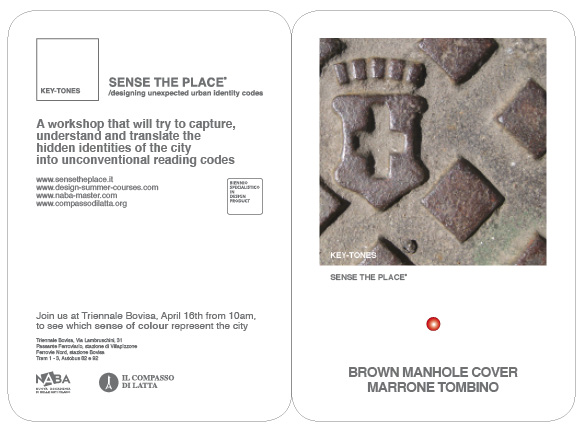A series of workshops in direct contact with the urban fabric of the city of Milan, to observe the city through the 5 + 1 senses – a specific field research project – aimed at capturing, understanding and transforming hidden identities into simple reading systems. A true “design process” that can describe complex systems in terms of project communication codes, through the use of cognitive mapping.
Professional staff will accompany this project through a multidisciplinary approach based on information sharing. The point of departure for “SENSE THE PLACE” workshops is a colour mapping from where the project moves on to investigate those fonts that can best represent the city’s identity, its texture, its sounds, its smells, its tastes, its distinguishing marks, etc… These macro-categories, in turn, lead to in-depth reflections on contemporaneity, on communality, on day to day life, on people, and on all those things that surround us without being noticed, all of which are narrated in an unconventional way.
Design attitude: project relevance
5+1 senses of Milan
key-moods > sense the place
key-tones > sense of color
key-fonts > sense of sign
key-symbol > sense of mark
key-texture > sense of touch
key-vibes > sense of sound
key-smells > sense of smell
key-flavours > sense of taste
Moods = urbanity, sociality, usability, adaptability, people, places, scale, neighborhood, behaviors, habits, cultures, cultural-mix, diversity, fifty-fitty, 24h, paths, cityscapes, dynamism, temporary, dwell, permanent, journey, deliver, devices, tools, materic, stikiness, slippery, fragrances, smart grids, rumors, daily snatches, tone of voice, politics, benefits, deseases, noises, dirt, violation, provisions, trading, marketplace, producing, residual energy, expired, vital
Key-tones
During the “Fuori Salone 2010″, at the “Triennale Bovisa” Museum in Milan, the two year “Product Design” course has worked on the Key-tones project. A meticulous photographic reportage on the urban identity of Milan aimed at identifying the colour code that best characterizes the city.
A map measuring 7 meters in length and 2 meters wide displays over one thousand macro details that are organized in a chromatic system that is similar to the language used by Pantone.
Creating the colour charts that define Milan.
What gives Milan its shades of green?
What gives Milan its shades of red?
What gives Milan its shades of purple?
What gives Milan its shades of magenta?
What gives Milan its shades of brown?
What gives Milan its shades of white?
What gives Milan its shades of black?
What gives Milan its shades of grey?
What gives Milan its darker shades of blue?
What gives Milan its lighter shades of blue?
What gives Milan its shades of orange?
What gives Milan its shades of yellow?


